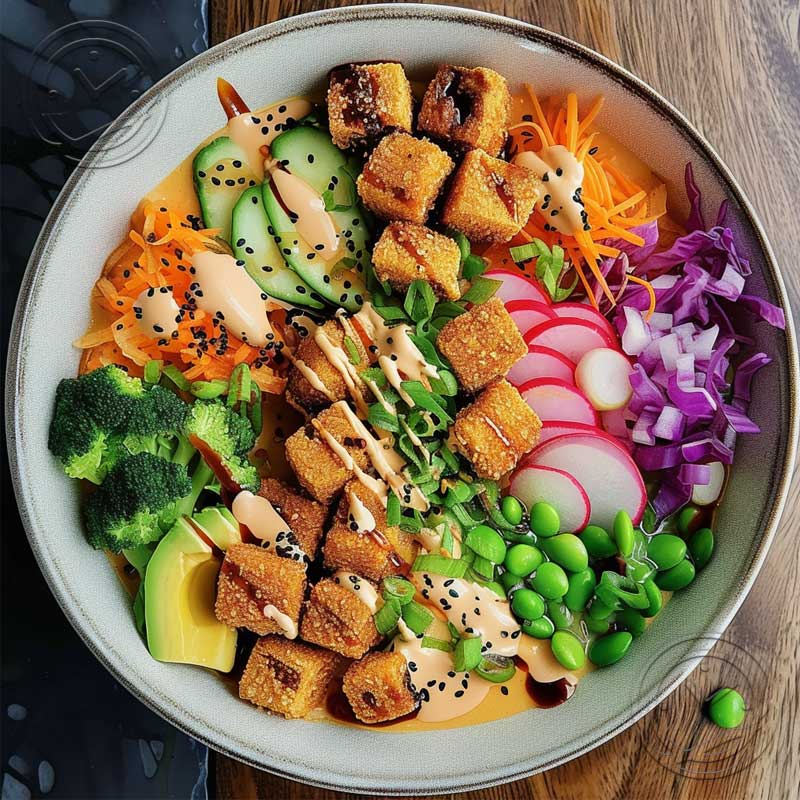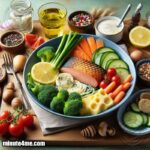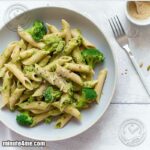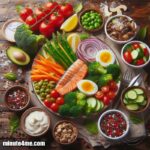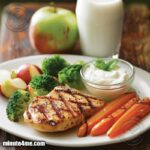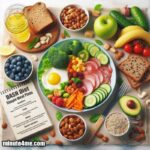Introduction to Flexitarian Diet
The flexitarian diet is a modern approach to eating that combines the health benefits of a plant-based diet with the flexibility of occasional meat consumption.
This diet is gaining popularity for its balance and adaptability, offering a practical solution for those looking to improve their health without giving up meat entirely.
Flexitarian Diet 7-Day Meal Plan
6 Simple DASH Diet Dinner Recipes
Unlock the secret to a healthier heart and a vibrant lifestyle with our 6 Simple DASH Diet Dinner Recipes! Designed…
Day 1:
- Breakfast: Starting your day with Greek yogurt mixed with berries and granola is a delightful way to wake up your taste buds. This combination not only provides a good source of protein from the yogurt but also includes antioxidants from the berries and fiber from the granola, making it a balanced and nutritious choice for breakfast ideas.
- Lunch: For lunch, a black bean and corn salad served with avocado and whole-wheat tortillas offers a satisfying meal. Black beans are excellent protein sources, and together with corn, they provide a complete protein profile. Avocado adds healthy fats, essential for nutrient absorption, while whole-wheat tortillas contribute to your daily whole grain intake.
- Dinner: Tofu stir-fry with brown rice and a variety of vegetables is an excellent way to end your day. Tofu, a staple in many vegetarian recipes, is a versatile and high-protein ingredient. Brown rice, a whole grain, complements this dish by adding fiber and additional protein. The variety of vegetables increases the meal’s vitamin and mineral content, making it a nutritionally dense dinner option.
Day 2:
- Breakfast: Scrambled eggs with spinach and whole-wheat toast offer a perfect balance of protein, iron, and complex carbohydrates. Eggs are a high-quality protein source, while spinach provides iron and essential vitamins. Whole-wheat toast adds a satisfying crunch and fibers, essential for a healthy digestive system.
- Lunch: A warm bowl of lentil soup accompanied by a fresh side salad is both comforting and nutritious. Lentils are a powerhouse of nutrition, providing protein, fiber, and essential minerals. The side salad adds freshness and a variety of nutrients, making this a balanced lunch for weight loss and overall health.
- Dinner: Salmon with roasted sweet potatoes and broccoli is not only a delicious dinner choice but also a nutrient powerhouse. Salmon is rich in omega-3 fatty acids, crucial for heart health and brain function. Sweet potatoes are a great source of beta-carotene and complex carbohydrates, while broccoli adds fiber and vitamin C to this meal.
Indulge in a culinary adventure with Flexitarian Pasta Recipes. Blend the richness of vegetarian delights with occasional meaty treats for…
Day 3:
- Breakfast: A smoothie made with banana, spinach, almond milk, and protein powder is an excellent way to start a busy day. This breakfast idea is not only quick and convenient but also packed with nutrients. Bananas provide natural sweetness and potassium, spinach offers iron and vitamins, almond milk adds a dairy-free calcium source, and protein powder ensures you’re getting enough protein.
- Lunch: For lunch, a quinoa bowl with chickpeas, roasted vegetables, and tahini dressing is a delightful mix of flavors and textures. Quinoa and chickpeas together make a complete protein, essential for vegetarians. Roasted vegetables add depth of flavor and antioxidants, while tahini dressing provides healthy fats.
- Dinner: Vegetarian chili served with cornbread makes a hearty and satisfying end to the day. The chili, loaded with beans and vegetables, is a great source of plant-based protein and fiber. The cornbread complements the chili and adds a comforting element to this meal.
Day 4:
- Breakfast: Overnight oats mixed with chia seeds and topped with fruit are a fantastic make-ahead breakfast. Oats and chia seeds provide a substantial amount of fiber, keeping you full longer. Adding fruit not only enhances the flavor but also contributes vitamins and minerals.
- Lunch: A turkey sandwich on whole-wheat bread with avocado and lettuce is a great combination of lean protein, healthy fats, and whole grains. Turkey is a low-fat protein source, while avocado provides monounsaturated fats. Whole-wheat bread rounds out this meal with its fiber content.
- Dinner: Veggie burgers on whole-wheat buns accompanied by sweet potato fries are a fun and nutritious way to end the day. Veggie burgers are an excellent source of plant-based protein and when served on whole-wheat buns, they add an extra dose of fiber. Sweet potato fries are a healthier alternative to regular fries and are rich in vitamin A.
5 Easy Nordic Diet Dessert Ideas
The Nordic diet, renowned for its emphasis on fresh, seasonal ingredients and minimal processing, offers a delicious pathway to health…
Day 5:
- Breakfast: Whole-wheat pancakes topped with fruit and a drizzle of maple syrup offer a satisfying and wholesome start to the day. Whole-wheat flour increases the fiber and nutrient content compared to traditional pancakes, while the fruit provides natural sweetness and vitamins.
- Lunch: A salad with grilled chicken breast, quinoa, and balsamic vinaigrette is a perfect midday meal. The chicken breast is a lean protein source, quinoa adds plant-based protein and fiber, and the balsamic vinaigrette adds a tangy flavor without excess calories.
- Dinner: Shrimp scampi served with whole-wheat pasta and zucchini is a delicious and light meal. Shrimp is a low-calorie protein source, whole-wheat pasta provides sustained energy, and zucchini adds bulk and nutrients without many calories, ideal for those monitoring their weight loss journey.
Day 6:
- Breakfast: A tofu scramble with bell peppers and onions is a vibrant and nutrient-dense way to start your day. Tofu is a great source of plant-based protein, while bell peppers and onions add flavor, vitamin C, and antioxidants.
- Lunch: Leftover veggie burgers with a side salad make for a quick and nutritious lunch. This meal is a great way to utilize leftovers while ensuring you’re getting a good balance of protein, fiber, and vitamins.
- Dinner: Lentil pasta with marinara sauce and roasted vegetables is a comforting and healthy way to end your day. Lentil pasta is a high-protein, high-fiber alternative to traditional pasta, making it a great choice for those on a plant-based diet.
Day 7:
- Breakfast: Eggs Benedict with whole-wheat English muffins and avocado is a luxurious yet healthy way to start your final day of the week. The eggs provide high-quality protein, the whole-wheat English muffins add fiber, and the avocado offers healthy fats.
- Lunch: Enjoying leftover lentil soup with a side of fruit is an excellent way to ensure you’re getting a nutrient-rich meal without much preparation. Lentil soup is filling and full of fiber, while fruit adds a refreshing and sweet touch to your lunch.
- Dinner: Grilled salmon with quinoa and asparagus is not only a delicious way to end the week but also a meal packed with nutrients. Salmon provides essential omega-3 fatty acids, quinoa is a complete protein source, and asparagus is rich in vitamins and fiber.
Health Benefits of a Flexitarian Diet
A flexitarian diet can lead to improved overall health, including reduced risk of chronic diseases like heart disease and diabetes.
The high fiber intake and reduced saturated fat are key factors in these health benefits.
Opting for a flexitarian diet can also lessen the environmental impact of food production, supporting sustainability goals.
Flexitarian Tips for Success
- Plan your meals and snacks in advance.
- Keep a grocery list of healthy staples like fruits, vegetables, and whole grains.
- Cook in bulk and freeze leftovers for convenience.
- Choose lean protein sources and healthy fats.
- Don’t be afraid to experiment with new recipes.
- Listen to your body and practice portion control.
Conclusion
The flexitarian diet is an adaptable and health-conscious way to eat, offering a variety of delicious meal options.
It’s a sustainable lifestyle choice that balances personal health with environmental responsibility.
By following this 7-day meal plan and embracing the tips for success, you can embark on a journey of flavorful and nutritious eating that benefits both your body and the planet.
